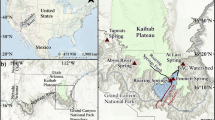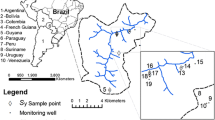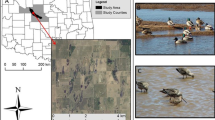Abstract
Annual water budgets spanning 2 years, 2004 and 2005, are constructed for a sinkhole wetland in the Tennessee Highland Rim following conversion of 13 % of the watershed area to impervious surfaces. Surface runoff was the dominant input, with a contribution of 56.4 % of the total. An average of 18.9 % of gross precipitation was intercepted by the canopy and evaporated. Deep recharge varied from 55.5 % (2004) to 52.2 % (2005) of total outflow. Evapotranspiration accounted for 46.2 % of the total losses, with an average of 50.3 % lost from soil profile storage. The annual water budgets indicate that deep recharge is a significant hydrologic function performed by isolated sinkhole wetlands, or karst pans, on the Tennessee Highland Rim. Continued hydrologic monitoring of sinkhole wetlands are needed to evaluate hydrologic function and response to anthropogenic impacts. The regression technique developed to estimate surface runoff entering the wetland is shown to provide reasonable annual runoff estimates, but further testing is needed.






Similar content being viewed by others
References
Allen RG, Pereira LS, Raes D, Smith M (1998) Crop evapotranspiration guidelines for computing crop water requirements. Land and Water Development Division, Food and Agricultural Organization of the United Nations, Rome
Arnold JG, Potter KN, King KW, Allen PM (2005) Estimation of soil cracking and the effect on surface runoff in a Texas blackland prairie watershed. Hydrological Processes 19(3):589–603
Brinson MM (1993) A hydrogeomorphic classification for wetlands. U.S. Army Engineer Waterways Experiment Station, Vicksburg, MS, USA. Wetlands Research Program Technical Report WRP-DE-4
Brooks RT (2009) Potential impacts of global climate change on the hydrology and ecology of ephemeral freshwater systems of the northeastern United States. Climate Change 95:469–483
Favero L, Mattiuzzo E, Franco D (2007) Practical results of a water budget estimation for a constructed wetland. Wetlands 27(2):230–239
Greear PF (1967) Composition, diversity, and structure of vegetation of some natural ponds in Georgia. Ph.D. Dissertation. University of Georgia, Athens
Hargreaves GH, Samani ZA (1985) Reference crop evapotranspiration from temperature. Applied Engineering in Agriculture 1(2):96–99
Hendricks EL, Goodwin MH (1952) Water-level fluctuations in limestone sinks in southwest Georgia. P. 157–245. In Contributions to the Hydrology of the United States, 1948–1952. U.S. Geological Survey Water Supply Paper 1110
Hill AJ (2007) Monitoring and modeling the hydrology of a forested sinkhole wetland on the Tennessee highland rim. Ph.D. dissertation. Tennessee Technological University, Cookeville
Hill AJ, Neary VS (2007) Estimating evapotranspiration and seepage for a sinkhole wetland from diurnal surface water cycles. Journal of the American Water Resources Association 43(6):1359–1619
Hill AJ, Neary VS (2009) Hydrologic response of a forested sinkhole wetland to different land management scenarios. J Environ Hydrol, Volume 17, Paper 5
Hill AJ, Neary VS, Morgan KL (2006) Hydrologic modeling as a development tool for HGM functional assessment models. Wetlands 26(1):161–180
Johnson MS, Lehmann J (2006) Stemflow and root-induced preferential flow: the double-funneling of trees. Ecoscience 13:324–333
Kadlec RH, Wallace SD (2009) Treatment wetlands. Taylor and Francis Group, Boca Raton
Mansell RS, Bloom SA, Sun G (2000) A model for wetland hydrology: description and validation. Soil Science 165:384–397
Millar JB (1971) Shoreline-area ratio as a factor in the rate of water loss from small sloughs. Journal of Hydrology 14:259–284
Moran J, Kelly S, Skeffington MS, Gormally M (2009) The use of GIS techniques to quantify the hydrological regime of a karst wetland (Skealoghan turlough) in Ireland. Applied Vegetation Science 11(1):25–31
O’Driscoll MA, Parizek RR (2003) The hydrologic catchment area of a chain of karst wetlands in central Pennsylvania, USA. Wetlands 23(1):171–179
O’Driscoll MA, Parizek RR (2008) Geological controls on seasonal-pool hydroperiod in a karst setting. Wetlands 28(4):1004–1017
Poiani KA, Johnson WC, Swanson GA, Winter TC (1996) Climate change and northern prairie wetlands: simulations of long-term dynamics. Limnology and Oceanography 41(5):871–881
Ponce VM (1989) Engineering hydrology, principles and practices. Prentice-Hall, Englewood Cliffs
Shofner GA, Mills HH, Duke JE (2001) A simple map index of karstification and its relationship to sinkhole and cave distribution in Tennessee. Journal of Cave and Karst Studies 63(2):67–75
Sprecher SW (2000) Installing Monitoring Wells/Piezometers in Wetlands, ERDC TN-WRAP-00-02, U.S. Army Research and Development Center, Vicksburg, MS
Sun G, Callahan TJ, Pyzoha JE, Trettin CC (2006) Modeling the climatic and subsurface stratigraphy controls on the hydrology of a Carolina bay wetland in South Carolina, USA. Wetlands 26:567:580
Tiner RW (2003) Geographically isolated wetlands of the United States. Wetlands 23:494–516
U.S. Department of Agriculture (1992) Soil survey for Putnam County, Tennessee. Soil Conservation Service, TN
Van der Kamp G, Hayashi M (1998) The groundwater recharge function of small wetlands in the semi-arid northern prairies. Great Plains Research 8:39–56
White WB (1988) Geomorphology and Hydrology of Karst Terrains. Oxford University Press, Inc., NY
Winter TC (1981) Uncertainties in estimating the water balance of lakes. Journal of the American Water Resources Association 17(1):82–115
Wolfe WJ (1996) Karst wetlands on the Barrens, geomorphic control of wetland hydrology and plant distribution on the Highland Rim of Tennessee. Ph.D. Dissertation. Clark University, Worchester
Author information
Authors and Affiliations
Corresponding author
Electronic supplementary material
Below is the link to the electronic supplementary material.
ESM 1
Top elevation, installation depth, ground elevation, and screened aquifer for 11 monitoring wells shown in Fig. 2. Note: Lowest elevation in wetland = 29.212 m. (DOC 66 kb)
ESM 2
Measured monthly gross precipitation, throughfall, and canopy interception from May 2004-December 2005: (a) Interception as a % of gross precipitation; error bars indicate one standard error and (b) Gross precipitation and throughfall totals. (DOC 113 kb)
ESM 3
Measured minimum and maximum temperatures and solar radiation and reference evapotranspiration (ETo) calculated with the FAO Penman-Monteith equation from 2004 to 2005. (DOC 137 kb)
ESM 4
Assumed temporal distribution of crop coefficient (kc) used to calculate potential ET from reference evapotranspiration estimates (ETo). Independent estimates of kc calculated from data reported by Hill and Neary (2007) are shown for comparison. (DOC 266 kb)
ESM 5
Comparison of ET estimates calculated with the Penman-Monteith equation to independent estimates reported by Hill and Neary (2007). (DOC 270 kb)
ESM 6
Comparison of surface water (SW, solid line) elevations to water level elevations in monitoring wells during the reemergence of ponded conditions in September of 2004. (DOC 115 kb)
ESM 7
Comparison of surface waer (SW, solid line) elevations to water level elevations in monitoring wells for 7 months in 2005. (DOC 169 kb)
ESM 8
Relationship between wetland stage and hydraulic gradient for 5 wells. Refer to Fig. 2 for well locations. Stage values are measured at well WCW. Negative values of stage indicate the water table is below the ground surface. Negative values for hydraulic gradient indicate discharge conditions. (DOC 68 kb)
Rights and permissions
About this article
Cite this article
Hill, A.J., Neary, V.S. Annual Water Budgets for a Seasonally Inundated Sinkhole Wetland. Wetlands 32, 963–974 (2012). https://doi.org/10.1007/s13157-012-0331-7
Received:
Accepted:
Published:
Issue Date:
DOI: https://doi.org/10.1007/s13157-012-0331-7




